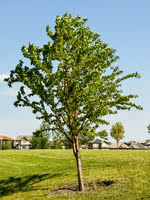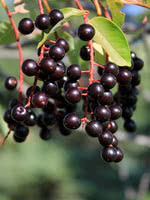Mon-Fri 9am - 5pm Mountain time
Amur Cherry vs Western Chokecherry
Prunus maackii
Prunus virginiana var. demissa
NOT AVAILABLE THIS SEASON - MIGHT RETURN
Amur Cherry is a beautiful, fast-growing ornamental tree. It features attractive bronze/red bark that peels horizontally in strips.
This hardy tree bears white flowers in the spring, black fruit held in clusters in the late summer, and pointy leaves that turn yellow in the fall.
Western Chokecherry is a shrub or small tree commonly used for farmstead and field windbreaks.
It produces white flowers in the spring and edible dark purple fruit that matures between September and October. Its cherries are great for making for making jams, jellies or wine, but are not very palatable for raw eating.

